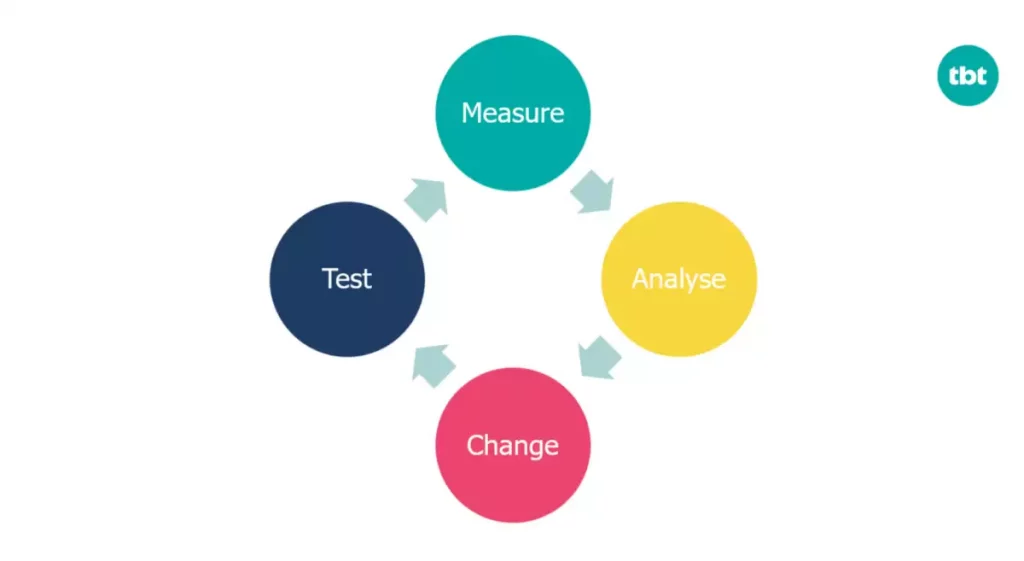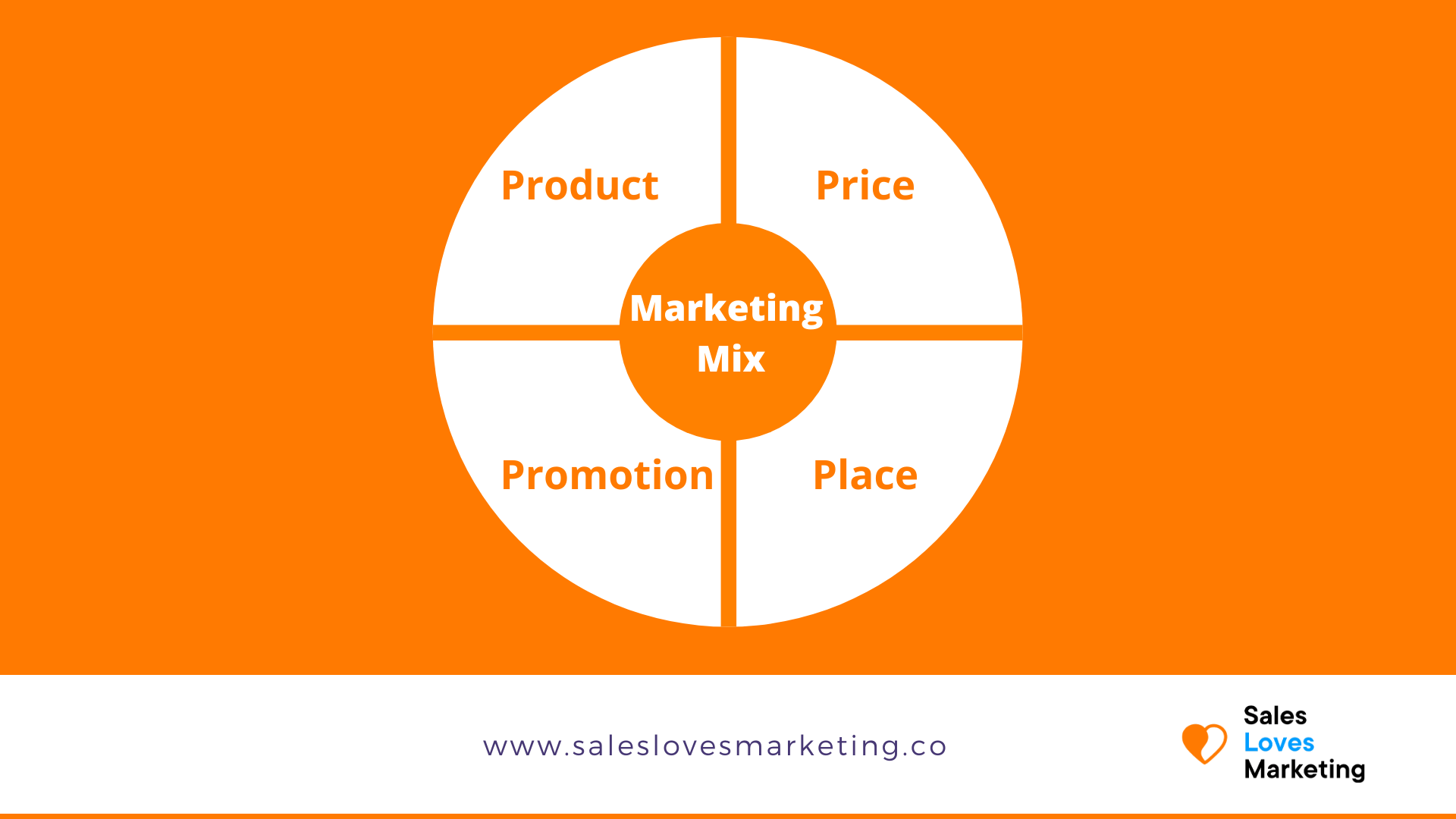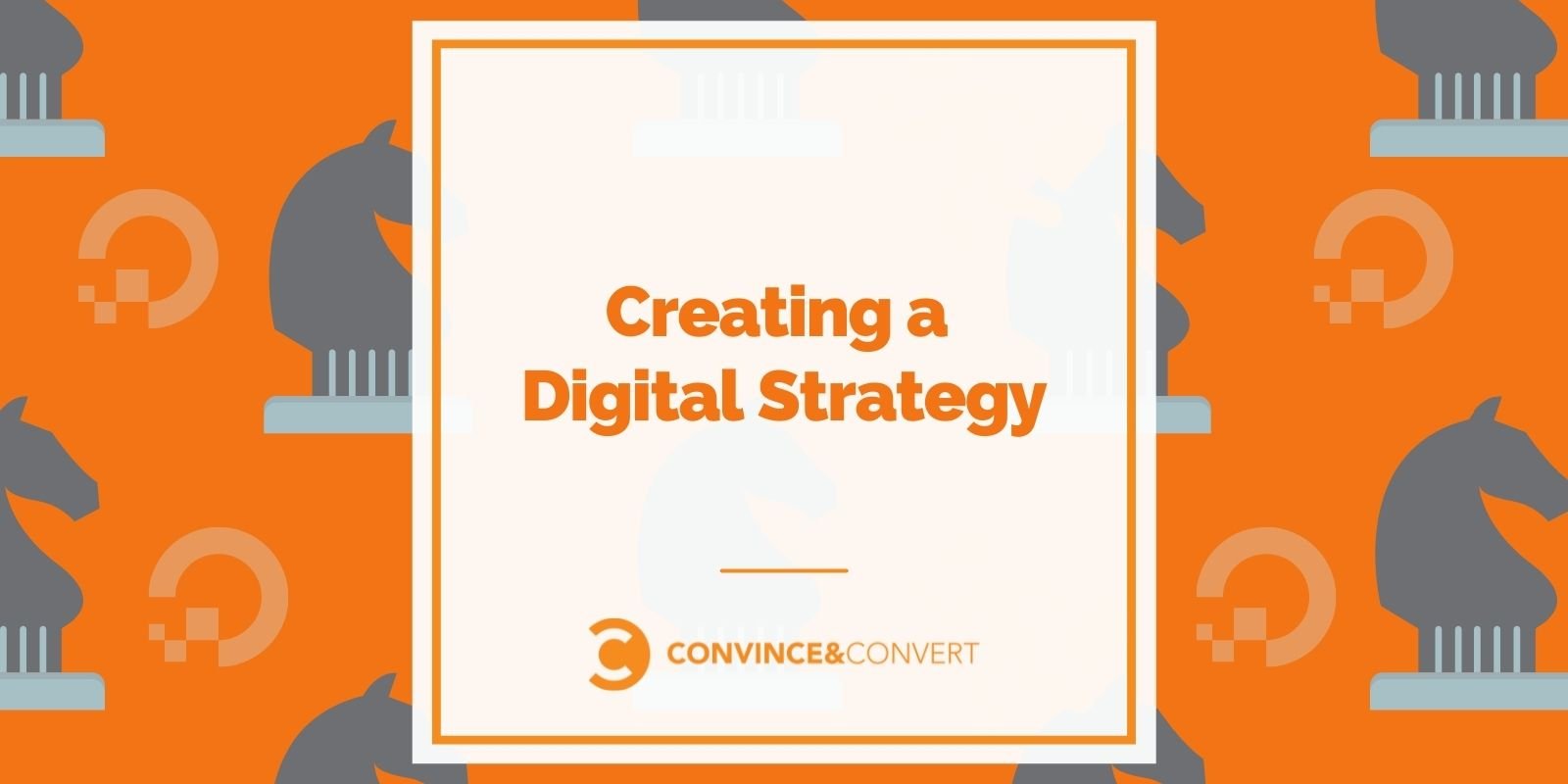An interview with Anthony Helmstetter, Strategist at Convince and Convert
What are the key parts of digital strategy?
A digital strategy is a bit of a misnomer, because it overlooks the offline elements that need to be incorporated for a full, well-rounded marketing strategy.
Let’s simply call it what it is in totality: a marketing strategy. There are digital components like the website, SEO, emails, social media, online ads, etc., but don’t ignore the offline elements like customer service, traditional advertising tactics, and possibly old-fashioned telephone communications.
All the parts, digital or not, need to work seamlessly together for your strategy.
Where do I get started when creating a digital marketing strategy?
To come up with the marketing strategy, figure out your starting point. It’s like the old analogy: you have to know where you are before a map is going to do you any good.
You need to know your objective. What is it you’re trying to accomplish? What’s the marketing strategy supposed to do? The strategy can be a huge overarching strategy for the company for the entire year or it could be a small column of micro-strategy for a new product launch.
You have to know where you are before a map is going to do you any good.
Click To Tweet
Once you figure out where you are,ascertain the resources that you have. Take inventory of available personnel, budget, time, and expertise. Rarely does a marketing manager have everything they want. There are almost always resources constrained in some areas where they wish they had more help. You’ll start off on a better foot by doing a gap analysis and figuring out where you need additional support to pull off your marketing strategy.
Determine what future state you want to achieve. Unlike the objective itself, which might be the bigger picture, the future state has to be specific. We’re trying to: move X number of units, enter a new territory, launch a new product, stave off a competitive threat, etc. You need to know how you are going to do that in order to form the actual strategy itself.
Take this analogy to start: Here’s a bunch of ingredients we have in the cupboard. What can we make? What meal can we put together?
The more experience the marketer or the marketing team has, the better. It’s like the more chefs or cooks you talk to, they draw on their collective experience with these ingredients. Figure out what you can do and it’s completely okay to say, “We’re missing some things that we have to go get.”
Put in the work to figure out the start of your digital strategy
It can be hard to figure out where you stand depending on your organization’s size, your department, or the size of the undertaking. The easiest place to be is at a startup starting with nothing. And yet, it’s also the hardest, because you have nothing.
In most cases, there is marketing that is underway already.
The hardest scenario is probably when the marketing manager or CMO steps into a new environment. They are transferred to another division or they’re new to the company, and then they have to figure out where they are because they’re dealing with what’s already in motion. You still have to take inventory of the resources that you have. It’s just harder in that case.
If you are already comfortable with the operations of the organization and culture, then it shouldn’t be too hard to figure out what you have at your disposal, because you’re already using it.
Once you have the lay of the land, what’s next?
This is the fun part. Now you have to create a solution that doesn’t exist yet, so you get to draw on inspiration. You can look at what others have done or you can consult with your team.
One of the things we frequently recommend is going out and getting real research. If you have a marketing objective, or a business objective that has a marketing component to it, it’s really good to get the input from the people who are going to be impacted like customers or prospective customers. It could also involve the sales team, the customer success team, the customer service team, product marketing or operations.
Any marketer who sits in isolation and sets out to implement a strategy without research or consultation either has to be really experienced, really lucky, or really foolish, because the marketing objective is designed to alter behavior. What are the triggers that are going to be more effective versus less effective? You really have to have a good understanding of whose behavior you are trying to alter and how to accomplish that.
There is no better substitute than going directly to the source and asking the people you want to persuade or motivate about their opinions. It’s one of the simplest things to do and yet it’s often a lacking step.
Any marketer who sits in isolation and sets out to implement a strategy without research or consultation either has to be really experienced, really lucky, or really foolish.
Just like sales people talk to prospective customers all the time, marketers have to get in there as well. Especially when it’s a new audience, it’s good to dive in and learn that audience. You can take the word of the salespeople, but we see a lot of successful organizations where the marketer sits in on sales calls to get to know the people.
Third-party research is helpful, too. There’s more data available now than ever before, so it’s silly not to take advantage of it.
Enter the Feedback Loop
Marketing is driving a whole bunch of leads and Sales isn’t closing them. Sales says all these leads are crap. Sales says we want more high quality leads and Marketing is not delivering. Marketing says they are driving tons of leads and Sales isn’t doing their job. Sound familiar?
You need to avoid this age old friction between these departments. Sales and Marketing need to merge together because at the end of the day they all have the same objective. Marketing needs to listen to Sales and Sales need to understand the marketing objective and the benefits.
You might get an early warning from social media and other outlets, but someone’s got to be listening.
Good sales departments figure out the competitive landscape or else they wouldn’t be good sales departments. Sales has to be involved in the marketing strategy and they’re an essential part of the feedback loop. If something is amiss, if the marketing message is not resonating, if the price is wrong, it’s usually sales or customer service that’s going to get hold of that information. You might get an early warning from social media and other outlets, but someone’s got to be listening and that feedback must get back to Marketing so that they can assess and adapt.

“Following this simple model will help to ensure that your marketing feedback loops are always providing you with the most up-to-date recommendations for improving your activities. Just make sure you’re applying it at every stage of the journey.” / TBT Marketing, 7 Oct 2019
That sounds simple enough at a high level, but there are a lot of details within and that is when it gets tactical.
What’s the difference between a marketing strategy and a marketing plan?
The marketing, or digital marketing, strategy is a higher level, overarching strategy. The marketing plan drills down into more of the details of what’s going to happen. Plans typically get into tactics and involve timeframes and budgets. You can detail what is involved in week 1, week 2 and so on along with metrics and analysis.
For the plan, you can adjust your budget spend accordingly between paid outlets.
The marketing plan is aspirational and they do end up changing and adapting, because the marketing plan is by design created in advance. It’s a plan, not the end result.
Recall the feedback loop. You need to get new information so you can adjust tactics within the plan, budgets, the messaging, etc. Those are part and parcel to the plan. Every plan should be evolving. I mean, no one just launches one plan and says, “That’s it. I hope it works!”.
You launch a plan with the expectation you’re going to learn as much as you can, as fast as you can, and then adapt and optimize as agilely as you can.
How do you know when your strategy is flawed?
You know your strategy is flawed as soon as someone tells you which is why the feedback loop is so important. As soon as the metrics are coming in saying something’s not resonating or something is amiss, you need to address it. Additionally, you know your strategy is off track as soon as the data is not tracking or trending the way you expect it to. Look at tactical execution and see if a tweak can be made or whether it’s a systemic problem.
You could have a really bad creative on your social media retargeting campaign, and that’s easier to catch. On a less granular level, what if you have misjudged where your audience is going to hang out? They’re not going to respond on the social media channel you expected because maybe they aren’t there. Your particular target audience may not be heavy into social. That’s something you need to figure out quickly.
Secondarily, it’s a common mistake to not set realistic goals and timeframes. You’ve got a sales quota you have to hit or you’ve got a new marketing strategy for XYZ and someone from Finance came up with the numbers you’re supposed to hit for reasons you don’t even know. You’re expected to just go do it. Well, your target audience may not be able to make decisions quickly enough, or they need time for their budget. Be sure to be aligned and set proper expectations internally.
Sometimes the opposite can happen and marketing plans can be runaway, wild successes that people didn’t anticipate and that’s a different problem. If you’re in a production constrained environment where you’ve got a supply chain or a development time for the product, or maybe you’re in a service business and there’s a finite amount of service hours, too much success can be a problem. Having a marketing strategy be too successful is a better problem to have, but it can still be a problem. As soon as your customer begins to suffer, your customer service begins to suffer which creates a new challenge.
Does the marketing strategy need to evolve?
If you think your strategy won’t need to evolve, you’re likely asking the wrong people or going to the wrong data sources. Nothing in the marketplace or amongst competition is static. Micro and macro economics are not static. Products shift and consumer preferences shift. High level and very tactical changes are happening all the time, which is why we’re such big advocates of data and the feedback loop. The better the marketing managers have access to that data and those points, the better they’re able to adapt, maybe not in real time, but in near real time to work.
For example, if you’re head to head against a bigger, more established competitor and your marketing strategy is to try and take market share from them and in response they slashed their price to a break even, you have to respond to that. Those types of things happen all the time in the real world of marketing. Will you be ready to make your move?
So much has changed in marketing, do the traditional four P’s product, price, place and promotion still apply?
Yes, but depending on your circumstances, you might have to really be willing to stretch the definition of those four Ps: product, price, place and promotions.

Your marketing mix may be different by modern standards, but still serves you well when developing a marketing strategy. / Graphic by Sales Loves Marketing 8 Jun 2020
Let’s take online trading accounts where you can buy and sell stocks for example. Now there are free ones and one of the P’s are price. You have to be able to adapt to the definition of it. In this case, there is a price being paid but the price that’s being charged isn’t being paid by the end consumer. The price is being paid by the trading aggregator. They’re called market makers and they’re paying for bulk value for those online platforms. So yes, you do have a price but the way you market that price is not defined in the traditional four P’s. It’s very different, sometimes very complex, and sometimes very unclear.
Can you rush it? Can you create a strategy in a week?
You can rush strategy and sometimes there’s a need for that. Sometimes a quick marketing strategy is needed in conjunction with crisis management if something unanticipated is happening.
Although you can rush it, marketing strategy absolutely has to be malleable. Getting the appropriate data might take time, so you may have to deploy a new marketing strategy for a new initiative knowing that you don’t have all the pieces in place that you would ideally have. You will have to revisit knowing that it’s a constantly evolving marketing strategy.
What are some of the mistakes people make when creating their strategy?
The biggest mistake that we see repeated is people making a strategy without getting objective data and input from the sources that really matter. It’s easy to do what is familiar or what you did last time. If your old marketing strategy was completely based on sending direct mail and then suddenly that doesn’t work anymore, you have to adapt. Be aware of the changing environment.
For example, we have companies trying to quickly figure out how TikTok factors into their marketing strategy. What are the risks of doing it? What are the risks if they ignore it? There’s so much in our society, in technology, in consumerism, and even national and international pandemics that are in play. Data is quickly accessible. It’s a huge mistake to think, “I know what I’m doing. I have nothing left to learn.” That thinking is suboptimal and perhaps even disastrous.
Who should be involved in the creation of the digital strategy?
Anybody who is going to have customer contact or is involved in areas that impact customers should be involved in creating the strategy.
Here are people you should consider involving: product marketers, content creators, creative department, outsourced agencies, sales, customer service.
The executive team doesn’t necessarily have to be involved in the marketing strategy, but they need to understand and sign off on it. Also, at some point somebody has to approve the budget, which means finance is involved. Make sure they have proper representation and let them know what you need from them. Lay out the scenarios so they can get you what you need: good, better, and best case scenarios.
Outside the organization, research existing and prospective customers. There are people who are using your competitor’s product or services, and if that’s who you’re going after you need to resonate with. Don’t do something ignorant of what they think, feel or believe, or how they make decisions. The more data you collect, the better your chances of success are.
What is the main reason a marketing strategy fails?
Marketing strategies fail when you ignore critical information that is going to affect your success. That’s why the feedback loop is so important. Thankfully, it’s never been easier. We have better, deeper, faster access to reliable information now more than ever before. It goes beyond your web analytics or your sales yesterday. You need to look at the entire customer journey.
You have to identify points of friction and where mistakes are happening so customers can truly tell you what is going on. Ignoring the information is where marketing strategy fails. Strategy will change and at a minimum it will be fine tuned and optimized and made better over time. Without knowing what to do you’re just guessing.
Any final words of advice for our readers that are googling how to create a digital marketing strategy?
Do something quickly. People say learn fast; people say fail fast. There’s lots of expressions out there for marketing.
Time is not your friend but it’s constant. The faster you deploy your marketing strategy, the faster you start to get data from which you can make better decisions. Launching a half-baked marketing plan that takes you half the time than a fully-baked one is more ideal. You are going to get to your destination either way. Instead of using up time fine-tuning your educated guess, you can learn along the way and gather more solid feedback from an implemented strategy. Dive head first and you will find your way.
The post Creating a Digital Strategy appeared first on Content Marketing Consulting and Social Media Strategy.




